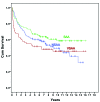Incidence and outcome of acquired aplastic anemia: real-world data from patients diagnosed in Sweden from 2000-2011
- PMID: 28751565
- PMCID: PMC5622852
- DOI: 10.3324/haematol.2017.169862
Incidence and outcome of acquired aplastic anemia: real-world data from patients diagnosed in Sweden from 2000-2011
Abstract
A plastic anemia is a rare life-threatening disease. However, since the introduction of immunosuppressive therapy and allogeneic stem cell transplantation, the outcome has improved considerably, and the 5-year survival is reported to be 70-80% in selected patient cohorts. Yet, contemporary population-based data on incidence and survival are lacking. We performed a national retrospective study to determine the incidence, treatment, and survival of patients with aplastic anemia diagnosed in Sweden from 2000-2011. Patients were included via the National Patient Registry, and diagnosed according to the Camitta criteria. In total, 257 confirmed cases were identified, with an overall incidence of 2.35 (95% CI: 2.06-2.64) cases per million inhabitants per year. Median age was 60 years (range: 2-92), and median follow up was 76 (0-193) months. Primary treatments included immunosuppressive therapy (63%), allogenic stem cell transplantation (10%), or single-agent cyclosporine/no specific therapy (27%). The 5-year survival was 90.7% in patients aged 0-18 years, 90.5% in patients aged 19-39 years, 70.7% in patients aged 40-59 years, and 38.1% in patients aged ≥60 years. Multivariate analysis showed that age (both 40-59 and ≥60 age groups), very severe aplastic anemia and single-agent cyclosporine/no specific therapy were independent risk factors for inferior survival. In conclusion, younger aplastic anemia patients experience a very good long-term survival, while that of patients ≥60 years in particular remains poor. Apparently, the challenge today is to improve the management of older aplastic anemia patients, and prospective studies to address this medical need are warranted.
Copyright© 2017 Ferrata Storti Foundation.
Figures




References
-
- Camitta BM, Thomas ED, Nathan DG, et al. Severe aplastic anemia: a prospective study of the effect of early marrow transplantation on acute mortality. Blood. 1976;48(1):63–70. - PubMed
-
- Cartwright RA, McKinney PA, Williams L, et al. Aplastic anaemia incidence in parts of the United Kingdom in 1985. Leuk Res. 1988;12(6):459–463. - PubMed
-
- Mary JY, Baumelou E, Guiguet M. Epidemiology of aplastic anemia in France: a prospective multicentric study. The French Cooperative Group for Epidemiological Study of Aplastic Anemia. Blood. 1990;75(8):1646–1653. - PubMed
-
- Szklo M, Sensenbrenner L, Markowitz J, Weida S, Warm S, Linet M. Incidence of aplastic anemia in metropolitan Baltimore: a population-based study. Blood. 1985;66(1):115–119. - PubMed
Publication types
MeSH terms
LinkOut - more resources
Full Text Sources
Other Literature Sources
Medical
Molecular Biology Databases

